Published on June 27, 2013
by Thomas C. Van Hare
As the day ended, Vice-Admiral Jisaburo Ozawa left the stricken aircraft carrier Taiho for the Imperial Japanese Navy destroyer Wakatsuki. From there, he intended to continue the battle. He found, however, that the radios on the destroyer could not support the level of communications required to command the ongoing engagement. After a short time, he transferred to another of his aircraft carriers, the Zuikaku. Only in the mid-afternoon of June 19, did he learn of the full dimensions of the day’s disastrous aerial attacks. Of the nearly 500 he had launched, only 150 were left on board the surviving seven aircraft carriers — two of his carriers, including his flagship, had been sunk.
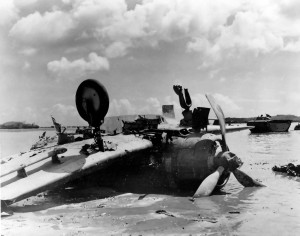
Reeling from the losses, Vice-Admiral Ozawa considered his options carefully. Based on his understanding of the situation, he reasoned that all was still not lost because he retained over 1,000 aircraft on Guam, planes that he thought were ready to attack the American fleet. Nonetheless, his options were limited. He would have to avoid an American aerial attack on his fleet and solely continue the attack from Guam. At that moment, as the sun set on June 19, 1944, he did not know that his land-based aircraft had been largely neutralized by the Hellcats from the fifteen American carriers of Task Force 58.
Issuing orders to Guam to launch attacks in the morning, Vice-Admiral Ozawa turned his fleet westward and sped away at 20 knots. His best hope was to escape the reach of the US Navy’s carrier-based planes, preserving the remaining seven aircraft carriers for another fight sometime in the future. As he predicted, the American fleet steamed west at flank speed. Their plan would be to find the Japanese and launch an air attack in the morning at dawn. The hunters had become the hunted.
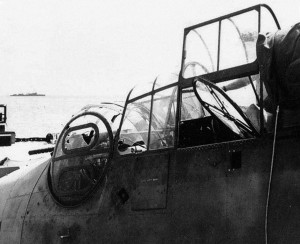
The Missing Fleet
Through the night and into dawn, the American task force launched extensive patrols, searching the waters in a wide arc that extended from the northwest through the west and southwest, ranging out hundreds of miles. Radar plots had confirmed that the Japanese aerial attacks of June 19 had definitely originated from that direction. It seemed reasonable that with the latest airborne radar systems, the American patrol planes would locate the Japanese in short order. Meanwhile, overnight, the American planes were readied across the entire fleet of 15 aircraft carriers. If the Imperial Japanese Vice Admiral Marc Mitscher reasoned, the Navy’s remaining seven aircraft carriers could be found and destroyed, the outcome in the Pacific War would be decided.
By dawn on June 20, 1944, however, the American patrol planes had turned up nothing. Incredibly, although the Japanese fleet numbered dozens of large ships, including aircraft carriers, battleships and cruisers, it had simply disappeared, as if into thin air. As the morning hours wore on into noon, the American commander, Vice Admiral Mitscher, grew increasingly restless. He ordered that large numbers of Grumman F6F Hellcats be launched to search as well, so that more of the ocean could be scoured for the Japanese fleet. A fleet that large should have been impossible to hide — and yet still, nothing was found. By 3:00 pm, all of the Hellcats had returned without any sighting whatsoever. There seemed no way that the Japanese could simply have gone missing.
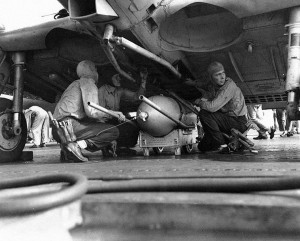
The Sighting
At 3:12 pm, the situation abruptly changed. A distant HF radio message was received from one of USS Enterprise’s long range patrol aircraft. The message was partial and garbled, but at least it could be understood that a sighting had been made, but where and how many ships? In what direction and speed was the enemy fleet sailing? Was it the whole fleet or just a part of it? With little more than the knowledge of what area the patrol plane had been assigned to search, several other patrol planes were redirected into that area. That order paid off when, at 3:40 pm, another patrol plane found the full Japanese fleet and reported its position, speed and heading. Incredibly, the Japanese had outraced Task Force 58 in their dramatic move to the west. Further, plotters in the coordinated CICs (Combat Information Centers) that were on board virtually every combat ship in TF 58 could quickly determine that the Japanese fleet was already near the edge of the maximum range of the Navy’s attack planes. Further, it was continuing westward and away at a speed of 20 knots.
With daylight hours short, at maximum range, could the planes reach the Japanese fleet, attack and return before dark? Planners determined that the attack was possible but that the planes would only return to their carriers in the dark of night. Further adding to the uncertainty was that the attack could only take place if the American pilots found the Japanese fleet immediately on arriving into the area — once the sun had set, the fleet would be lost in the darkness. Nonetheless, Vice Admiral Marc Mitscher ordered an all-out attack with everything he had. As pilots, navigators and gunners raced to their planes, the deck crews worked furiously to get them launched into the deepening afternoon skies.
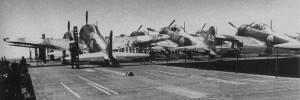
The first wave attack was launched and the second of two additional waves were being positioned onto the decks when another patrol plane reported a disturbing piece of news — the Japanese were fully 60 miles further west than originally reported. Calculations quickly determined that the second and third waves would only reach the target after nightfall. Only the first wave might find the Japanese with enough daylight to initiate an attack. Vice Admiral Marc Mitscher cancelled the second and third attack waves, but ordered that the first wave proceed. All hopes rode on the men of the first wave.
Sunset for the Rising Sun
As the sun touched the horizon, the Navy pilots and aircrew found themselves at the very limits of their range. Then, suddenly, the spotted the fleet, a vast collection of IJN ships that stretched in every direction, many silhouetted against the setting sun. Some of the aircraft carriers and a few of largest capital ships were located and the order was given to attack. Simultaneous dive bombing and torpedo plane attacks commenced in a textbook case attack plan that maximized the impact of naval air power by splitting the enemy’s AAA fire and defensive maneuvers so as to deal with both high and low attacks at the same time. Meanwhile, the escorting Hellcat fighter planes prepared to intercept any Japanese air cover.
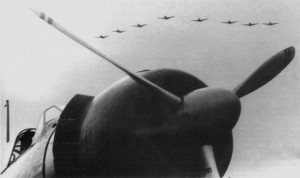
Minutes before, the Japanese fleet commander, Vice-Admiral Jisaburo Ozawa, received word of the approaching American planes. Quickly, he ordered his fighters launched. Just 35 of the advanced A6M5 Reisen “Zero” fighters were left from the previous day’s debacle, but he reasoned that it would be enough to blunt the attack. At that moment, the Japanese were familiar only with the types of attacks they had experienced in the past, such as at the Battle of the Coral Sea and at Midway, when each wave of attacking planes totaled anywhere from a few dozen planes to perhaps 70 or 80, most of which were dive bombers and torpedo planes. He felt that the 35 Zeroes should stop the majority of the heavier bombers and would likely shoot down many of the escorts as well. Instead, his pilots were stunned to find that the American attack numbered 240 aircraft. In fact, the escorting F6F Hellcats alone outnumbered the Japanese fighters.
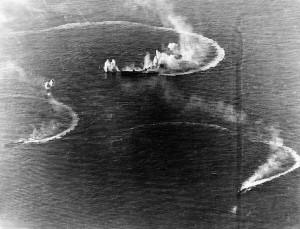
As the Hellcats dove on the rising defensive fighter screen of A6M5 Reisen Zeroes, the attack began in earnest. Hiyo was badly hit by planes from the American carrier USS Belleau Wood. Within minutes, Hiyo was dead in the water. Fires from one of the aerial torpedo hits blazed out of control below decks. With few options, the order was given to abandon ship. Before all the crew could abandon ship, however, the carrier’s stores of aviation fuel erupted into a huge fireball. Torn apart from the explosion, Hiyo slipped quickly beneath the waves. One thousand of its 1,250 men were rescued by destroyer escorts, but the rest perished.
Other squadrons hit the carriers Chiyoda, Junyo and even Zuikaku, where Vice-Admiral Jisaburo Ozawa had moved his command. Twice in two days, Ozawa had been aboard a carrier when it was attacked by the Americans, first by submarines and then by air power. Additionally, in the stressful minutes of the attack, the IJN battleship Haruna suffered serious hits as well as a number of the Japanese fleets oilers, of which two would later be abandoned and scuttled.
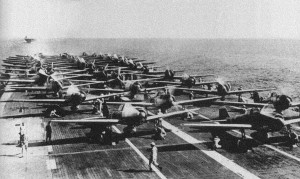
Aftermath of the Battle
As the American planes completed their attacks and turned eastward, they realized that just 20 aircraft had been lost to AAA and defensive fighters. The defending A6M5 Zeroes had been quickly dealt with by the Hellcat escort. While AAA fire had been intense, the attacks had been accomplished with speed and in a coordinated, well-practiced fashion. Night fell on the Japanese fleet. Of the nine carriers assembled by Ozawa for Operation A-Go, in two days, three had been sunk and another three damaged. Only about 100 planes of the once vaunted Japanese naval air power remained — gone were many veterans of the earlier Pacific combats, their experience and skills lost in the Marianas Turkey Shoot of the day before.
Yet for the Americans, with just 21 planes lost in exchange for nearly 400 of the enemy (including those sunk on the carriers), the mission was far from over. They were returning in the pitch black of night over the Pacific to a fleet that, based on the standard naval tactics would have to run with its lights all turned off. Only in that way could they avoid detection and attack by the many Japanese submarines that were known to be in the area. How many more airplanes and flight crewmen would be lost as a result when, low on fuel, unable to find a darkened fleet, they would have to ditch into the vast emptiness of the Pacific? Vice Admiral Mitscher concluded that he was likely to lose most of his force — and it wasn’t a fair deal.
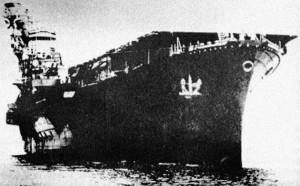
Recovery at Night
As the reality of the situation sank in, Vice Admiral Mitscher made a command decision. In a risky and bold move, he elected to damn the risk from submarines and turn on every light and search lamp in the fleet. In doing so, he knew too that strategically, Task Force 58 was likely sailing directly into a picket line of enemy subs that would likely have been deployed to help cover and delay the Japanese retreat. If the subs were there, they would see the American fleet from afar and close in for the attack. Further, with all the lights on, the American aircraft carriers would be easy targets. Yet without the lights, it was likely that many, if not most of the returning 220 aircraft would crash into the sea, unable to land. Nearly 400 pilots and aircrew were at risk and would likely be lost as a result.
As it happened, because of the bold decision of Vice Admiral Mitscher, most of the planes were able to land successfully on the decks of their carriers. Nonetheless, even with full illumination, 80 of the returning aircraft ditched into the sea, unable to land or running out of fuel before finding the fleet. Thankfully, the destroyers and support ships of TF 58 picked up the bulk of those men over the next few days, rescuing approximately 150 men from the waters. For the US Navy, the planes were unimportant and could be easily replaced by the vast network of industries supporting the war from the heartland of America. What mattered were the men — these were some of the best pilots and aircrew of the war, men who had cut their teeth in battle, some of whom had fought for many months in the hardest days of the Pacific War. Many were aces — if only from the previous day’s “Turkey Shoot”. They could not be replaced easily, nor quickly.
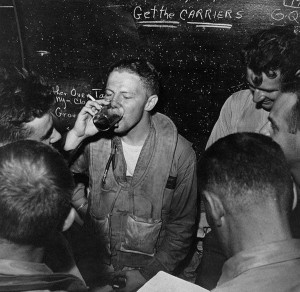
Aftermath
For the Japanese, a similar probably was hitting home. As Vice-Adminal Ozawa sailed his fleet west, fleeing toward Japanese home waters, he contemplated the future of IJN air power. The best, most experienced men were lost. Many had not only been veterans of the first campaigns of the war and every major battle since, but also had trained for years in the period of relative peace before the outbreak of the war, learning their skills over time and becoming true experts. Replacing them with rapidly trained recruits who were quickly qualified into ever more powerful and higher performance planes would be impossible. In the new era of aircraft carriers, ships that had emerged the key to victory at sea, the days of Japan’s naval power projection were all but over.
For the Americans, the Battle of the Philippine Sea was the key stroke that ended the bulk of Japan’s ability to wage warfare at sea. Without sufficient trained aircrew, it didn’t matter that the Japanese had over a half dozen aircraft carriers still in operation — what good were they if their planes were inferior and their pilots inexperienced novices? As a result of the Marianas Turkey Shoot, throughout the rest of the war, the Americans would engage in a relatively unopposed series of island invasions, “hopping” from one island chain to the next as the “noose closed” on mainland Japan. With the fall of Guam and later Iwo Jima, an intensive bombing campaign was launched against Japan itself with the new, large four engined Boeing B-29 Superfortresses flying from Guam, the very island chain that Vice-Admiral Ozawa had counted on to complete his grand strategy of Operation A-Go.
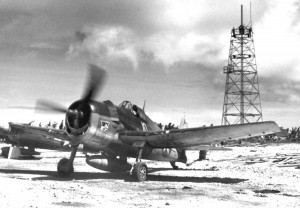
For the Japanese, despite the losses and the disaster of Operation A-Go, a few cards were still in hand. If the Americans couldn’t be engaged with carrier-launched aerial attacks, Japan would have to use a few extra aces that it still had up its sleeve. Indeed, the war was far from over. What was over, however, was the era of massed aircraft carrier fleets on opposing sides coming together to do battle at sea. If Midway in 1942 had been the turning of the tide, the Battle of the Philippine Sea had been the beginning of the final tsunami of destruction for Japan.
In the end, the Battle of the Philippine Sea set the stage for the bloodiest and most devastating ending of a war in history — but that is another story.

That photo showing an F6F “Night Fighter”….is not a night fighting equipped Hellcat, if it was it would have the radome on the wing…